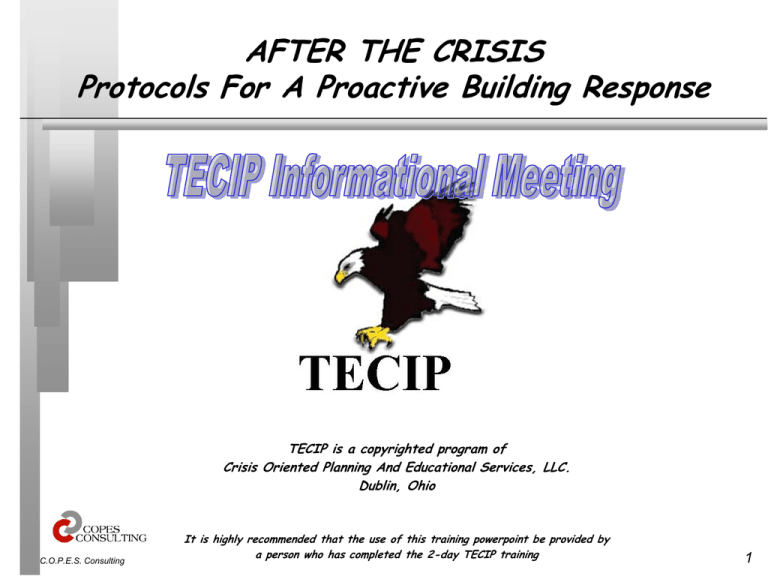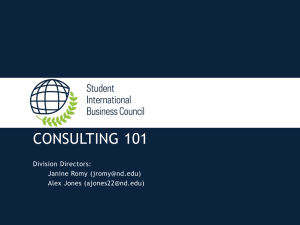"After the Crisis" Informational Meeting
advertisement

AFTER THE CRISIS Protocols For A Proactive Building Response TECIP is a copyrighted program of Crisis Oriented Planning And Educational Services, LLC. Dublin, Ohio C.O.P.E.S. Consulting It is highly recommended that the use of this training powerpoint be provided by a person who has completed the 2-day TECIP training 1 45-minute (to an hour) Time Manager 1. What is TECIP? 2. Our Reality 3. The Traumatic Event 4. Intervention Goals (SMARF) 5. Basic Student Needs (Needs Driven Assumptions) 6. Four Stage Management Plan 7. Traumatic Event Briefing 8. Classroom Discussion Guides 9. Teacher Go Packet 10. Our Next Steps C.O.P.E.S. Consulting 2 Traumatic Event Defined A critical incident (traumatic event) can be described as a sudden unexpected (sometimes expected) event that has an emotional impact sufficient to overwhelm the usual effective coping skills of an individual or a group and that causes significant psychological stress in usually healthy persons. Caine, Randy M. & Ter-Bagdasarian, L. (2003) C.O.P.E.S. Consulting 3 What is TECIP? C.O.P.E.S. Consulting TECIP is a field tested school-based framework for the AFTERMATH of a traumatic event. Initiated upon awareness of the event to support the first day back to school Two main systems • The Management Protocol & • The Embedded Intervention Strategies. 4 Our Reality… Note to presenter: change slide accordingly Identify as a group some of the events that may have taken place in your building or in your district. How did we meet the needs that first day back after knowledge of the event? Make the comparison to the measures we take every school year in preparing ourselves in the event of a fire, a tornado or need for lock down. Ask those in the group, with all these practice trials in place, why don’t we practice or prepare for what to do for incidents that have a much higher probability of occurring. C.O.P.E.S. Consulting 5 The Expectation 1) Standard of care requirement is coming to the schools as it relates to crisis intervention. 2) Standard of care is defined as “a generally recognized and accepted procedure, intervention, or pattern of practice”. 3) Key to the standard of care definition is the issue of expectancy which includes three components. a) plan b) team c) response (teams know what they are doing) C.O.P.E.S. Consulting 6 Are we prepared? Tonight, a student, her infant brother and mother are killed in a tragic house fire. How will our building respond? C.O.P.E.S. Consulting 7 Intervention Goals – S.M.A.R.F. 1. Stabilize/Clarify situation. 2. Mobilize resources. 3. Accelerate normalization of routine. 4. Restore adaptive functioning. 5. Facilitate access to more help. C.O.P.E.S. Consulting 8 Needs Driven Assumptions A. To effectively process a student’s grief, he or she will need a safe and secure environment. B. Coming to grips with one’s own vulnerability and mortality often heightens the need to belong. C. A controlled and predictable environment facilitates the healing process. D. Each student must be free to choose how they wish to deal with their emotional needs. C.O.P.E.S. Consulting 9 TECIP Management Protocol C.O.P.E.S. Consulting 1. Awareness (Information / Notification) 2. Planning (Personalizing protocol for a specific incident) 3. Implementation (Activating the response) 4. Closure (Advising staff of current status / Day 2 agenda/Team debriefing) 10 Traumatic Event Crisis Intervention Plan “The Official TECIP 4 by 5 Deployment Flowchart” Establish Awareness Inform building contact person Contact district communications office Apprise building crisis response team Verify details a. ID Scope b. ID Support Notify & inform staff C.O.P.E.S. Consulting Develop Plan Develop TECIP building implementation flow chart (rooms and areas) Identify direct intervention and management support team members Assign specific duties Prepare student announcement / Parent Letter Plan & Conduct Traumatic Event Briefing Implement Plan Bring about Closure Secure intervention room and areas Establish and outline staff meeting agenda items Dispatch team members to designated locations Conduct staff meeting Deliver student Announcement Distribute staff assessment Formally implement plan Develop plan for day 2 Monitor and communicate, as necessary, additional support needs Debrief crisis management team 11 Intervention Safety Net Large Gathering (TEB) Classroom Discussion Small Group Processing One-on-One (Peer Support) Outside Referral C.O.P.E.S. Consulting 12 Intervention Strategies Strategy Large Group/Traumatic Event Briefing Classroom Presentation Small Group Discussion C.O.P.E.S. Consulting Primary Goal To inform, consult and allow for psychological decompression, as well as stress management. To provide information, minimize unwanted student responses, normalize grief & trauma reactions, suggest appropriate behavior. To gather information, provide support to students, initiate mitigation of adverse reactions, and identify individuals who may need further support. 13 Large Group/ Traumatic Event Briefing C.O.P.E.S. Consulting 1. Assemble participants. 2. Provide facts regarding traumatic event. 3. Highlight and normalize common reactions. 4. Introduce building intervention focus/priorities. 5. Provide direction for stress management. 14 Point of Emphasis William Steele recommends that classroom presentations should be conducted by your own staff …because… Children in crisis look to their counselors, teachers, administrators for protection and help. Using outside sources frequently angers students, distances them from staff, “and chips away” at their trust in staff. “A Handbook of Interventions Following Suicide or Trauma in Schools’ 2001 C.O.P.E.S. Consulting 15 Classroom Presentation Guide C.O.P.E.S. Consulting 1. Introduce Presentation 2. Clarify the facts 3. Normalize common reactions 4. Identify appropriate behavior 5. Conclude Presentation 16 Teacher “Go” Pack Contents Required Support • At Risk List • List of Normal Reactions • Sign In/Sign Out Sheet • Handling Initial Reactions • Classroom Presentation Guide • Strategies for Significant Others • Hall Passes • Referral Sources (Sample) • Deployment Flow Chart Graphic • • Provide an Incident Fact Sheet Crisis Intervention Assumptions And Specific Actions C.O.P.E.S. Consulting 17 Keep the momentum in developing your TECIP team and plan 1) Identify the team’s short term goals, facilitators (what will help us with our goal) and inhibitors (what barriers can we anticipate) 2) Where do we see our plan in 3 months, 6 months, start and end of the school year 3) What factors will help us meet our goals 4) What factors might inhibit us from meeting our goals and how do we prepare for this. 5) Next meeting will be scheduled on (date) ________ at (time) ______. C.O.P.E.S. Consulting 18 What the next meeting will look like Review “Bringing TECIP back to your building: A Recommended Checklist ” for recommendations for followup meetings C.O.P.E.S. Consulting This TECIP Team meeting is entitled “Adding flesh to the skeleton”. Review each of the four components and add (where deemed appropriate by your team) any additional action steps In many cases, this meeting might be broken down into two separate sessions with the first session focusing on “Establishing Awareness” & “Developing Plan”, where the second session focuses on any additional action steps for “Implementing Plan” & Bringing about closure”. 19









